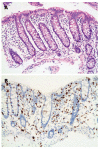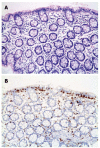Microscopic colitis as a missed cause of chronic diarrhea
- PMID: 21528078
- PMCID: PMC3082753
- DOI: 10.3748/wjg.v17.i15.1996
Microscopic colitis as a missed cause of chronic diarrhea
Abstract
Aim: To determine the prevalence of increased intraepithelial lymphocytes, using immunohistochemistry in patients with normal colonoscopy and near normal biopsy.
Methods: We retrospectively reviewed all non-malignant colon mucosal biopsies between 2005 and 2007, reported as normal, chronic inflammation or melanosis coli in patients who were undergoing routine colonoscopy. Immunohistochemistry using CD3 was performed on all mucosal biopsies and an intraepithelial lymphocyte count (IEL) was determined. Cases with an IEL count of ≥ 20 IELs per 100 surface epithelial cells were correlated with demographic, clinical and follow-up data. A further subgroup was evaluated for lymphocytic colitis.
Results: Twenty (8.3%) of 241 cases revealed an IEL count ≥ 20. Six (2.5%) patients were identified as having lymphocytic colitis (P < 0.001), of whom, five were missed on initial evaluation (P = 0.01). Four of these five patients were labeled with diarrhea-predominant irritable bowel syndrome (IBS). On follow-up, three of the remaining 20 cases were diagnosed with malignancy (renal cell carcinoma and myelodysplastic syndrome) and one had an unknown primary tumor with multiple liver metastases. Two cases of collagenous colitis with an IEL count < 10 were included in this study. Increased IELs were not confined to patients with diarrhea as a primary presenting symptom, but were also present in patients with abdominal pain (n = 7), constipation (n = 3) and loss of weight (n = 1).
Conclusion: Immunohistochemistry using CD3 is of value in identifying and quantifying IELs for the presence of microscopic colitis in patients with diarrhea-predominant IBS.
Keywords: CD3 immunohistochemistry; Collagenous colitis; Intraepithelial lymphocytes; Lymphocytic colitis; Microscopic colitis.
Figures


Similar articles
-
Microscopic colitis in patients with chronic diarrhea and normal colonoscopic findings in Southern China.Int J Colorectal Dis. 2012 Sep;27(9):1167-73. doi: 10.1007/s00384-012-1449-z. Epub 2012 Mar 21. Int J Colorectal Dis. 2012. PMID: 22430889
-
Clinical Implications of Microscopic Colitis Isolated to Polyps.Int J Surg Pathol. 2024 May;32(3):456-461. doi: 10.1177/10668969231185085. Epub 2023 Jul 10. Int J Surg Pathol. 2024. PMID: 37424329
-
[Concurrent lymphocytic colitis and microscopic enteritis in patients with chronic diarrhea].Rev Gastroenterol Peru. 2017 Oct-Dec;37(4):340-345. Rev Gastroenterol Peru. 2017. PMID: 29459804 Spanish.
-
[Microscopic colitis: histopathological review with a clinicopathological correlation].Pathologe. 2011 Jul;32(4):275-81. doi: 10.1007/s00292-011-1432-4. Pathologe. 2011. PMID: 21660478 Review. German.
-
[Microscopic colitis--more common cause of diarrhea than believed. Biopsies are the only way to diagnosis, drug treatment is effective].Lakartidningen. 2005 Aug 8-21;102(32-33):2210-4. Lakartidningen. 2005. PMID: 16145878 Review. Swedish.
Cited by
-
European guidelines on microscopic colitis: United European Gastroenterology and European Microscopic Colitis Group statements and recommendations.United European Gastroenterol J. 2021 Feb 22;9(1):13-37. doi: 10.1177/2050640620951905. Online ahead of print. United European Gastroenterol J. 2021. PMID: 33619914 Free PMC article.
-
Biopsy interpretation of colonic biopsies when inflammatory bowel disease is excluded.J Gastroenterol. 2012 Mar;47(3):226-48. doi: 10.1007/s00535-012-0539-6. Epub 2012 Feb 10. J Gastroenterol. 2012. PMID: 22322659 Review.
-
Microscopic Colitis in a Young Male: Unveiling the Rarity.Cureus. 2024 Jan 4;16(1):e51638. doi: 10.7759/cureus.51638. eCollection 2024 Jan. Cureus. 2024. PMID: 38313985 Free PMC article.
-
Low prevalence of 'classical' microscopic colitis but evidence of microscopic inflammation in Asian irritable bowel syndrome patients with diarrhoea.BMC Gastroenterol. 2013 May 8;13:80. doi: 10.1186/1471-230X-13-80. BMC Gastroenterol. 2013. PMID: 23651739 Free PMC article.
-
Effects of subspecialty signout and group consensus on the diagnosis of microscopic colitis.Virchows Arch. 2019 Nov;475(5):573-578. doi: 10.1007/s00428-019-02629-2. Epub 2019 Jul 29. Virchows Arch. 2019. PMID: 31359149
References
-
- Pardi DS, Smyrk TC, Tremaine WJ, Sandborn WJ. Microscopic colitis: a review. Am J Gastroenterol. 2002;97:794–802. - PubMed
-
- Fernández-Bañares F, Salas A, Forné M, Esteve M, Espinós J, Viver JM. Incidence of collagenous and lymphocytic colitis: a 5-year population-based study. Am J Gastroenterol. 1999;94:418–423. - PubMed
-
- Loftus EV. Microscopic colitis: epidemiology and treatment. Am J Gastroenterol. 2003;98:S31–S36. - PubMed
Publication types
MeSH terms
Substances
LinkOut - more resources
Full Text Sources
Medical

